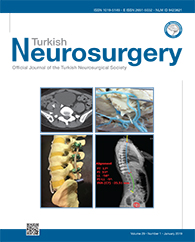2Marmara University, School of Medicine, Department of Neurosurgery, Istanbul, Turkey DOI : 10.5137/1019-5149.JTN.21827-17.2 AIM: To investigate a new anti-tumor treatment method using stem cells transfected with specific genes and proteins that induce apoptosis in tumor cells.
MATERIAL and METHODS: We used glioblastoma (GBM) cells and human adipose tissue-derived mesenchymal stem cells (ADMSCs) in this study. The AD-MSCs were transfected with the tumor necrosis factor-related apoptosis-inducing ligand (TRAIL). To overcome apoptosis resistance in tumor cells, we used suberoylanilide hydroxamic acid (SAHA) as the histone deacetylase inhibitor and embelin as the X-linked inhibitor of apoptosis protein (XIAP). In addition, we silenced the XIAP gene on GBM cells with the shXIAP plasmid. Following the determination of half-maximal effective concentration (EC50%) doses of SAHA and embelin, GBM cells were incubated with them for 24 hours. XIAP-silenced and XIAP-non-silenced GBM cells were cultured with TRAIL-nontransfected and TRAIL-transfected stem cells for 24 hours. Viability and cell cycle analysis of all groups were determined using annexin V/propidium iodide and cell cycle method via flow cytometry.
RESULTS: TRAIL-transfected AD-MSCs, XIAP silencing, embelin, and SAHA induced apoptosis in GBM cells and decreased their proliferation, whereas TRAIL-non-tranfected AD-MSCs did not.
CONCLUSION: Engineered stem cell therapies and molecular studies show promise in developing combination therapies for effective treatment of GBM.
Keywords : Embelin, Glioblastoma, Mesenchymal stem cell, SAHA, TRAIL




